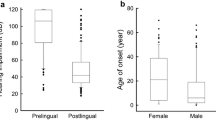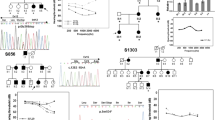Abstract
Hereditary etiology plays an important role in bilateral profound deafness as a main indication for cochlear implantation. Mutations in DFNB1 locus account for most of the inherited deafness cases in Caucasians. To provide actual data on mutation prevalence among implanted deaf subpopulation, we performed DNA analysis of GJB2 and GJB6 genes in 131 unrelated Slovak cochlear implant users. Eight previously described causal mutations and one probably pathogenic missense variant (c.127G>A) were detected in the GJB2 gene in 58 (44.28 %) subjects. The most common mutation found was c.35delG with frequency 83.02 % of all disease alleles, followed by c.71G>A, c.1-3201G>A, c.313_326del14, c.109G>A, 167delT, c.269T>C, and c.333_334delAA. GJB6 deletion delD13S1830 was identified in only one subject, in double heterozygosity with a GJB6 mutation. Thus, the deafness cause could be clearly attributable to DFNB1 mutations in 36.64 % of the patients examined. In summary, the mutation profile found in our cohort was similar to the mutation spectrum reported for Central European deaf populations. The mutation prevalence in cochlear implant users was, however, almost by 25 % higher than previously established for non-implanted hearing-impaired population in Slovakia. Finally, we also demonstrate a certain variability in deafness onset in patients with causal genotype and coincidence with other risk factors for deafness. Our results underline the importance of genetic tests in all cochlear implant candidates.
Similar content being viewed by others
References
Zelante L, Gasparini P, Estivill X et al (1997) Connexin26 mutations associated with the most common form of non-syndromic neurosensory autosomal recessive deafness (DFNB1) in Mediterraneans. Hum Mol Genet 6:1605–1609
Maw MA, Allen-Powell DR, Goodey RJ et al (1995) The contribution of the DFNB1 locus to neurosensory deafness in a Caucasian population. Am J Hum Genet 57:629–635
Snoeckx RL, Huygen PL, Feldmann D et al (2005) GJB2 mutations and degree of hearing loss: a multicenter study. Am J Hum Genet 77:945–957
Propst EJ, Stockley TL, Gordon KA, Harrison RV, Papsin BC (2006) Ethnicity and mutations in GJB2 (connexin 26) and GJB6 (connexin 30) in a multi-cultural Canadian paediatric Cochlear Implant Program. Int J Pediatr Otorhinolaryngol 70:435–444
Danilenko N, Merkulava E, Siniauskaya M et al (2012) Spectrum of genetic changes in patients with non-syndromic hearing impairment and extremely high carrier frequency of 35delG GJB2 mutation in Belarus. PLoS One 7:e36354
Bhalla S, Sharma R, Khandelwal G, Panda NK, Khullar M (2009) Low incidence of GJB2, GJB6 and mitochondrial DNA mutations in North Indian patients with non-syndromic hearing impairment. Biochem Biophys Res Commun 385:445–448
Godbole K, Hemavathi J, Vaid N, Pandit AN, Sandeep MN, Chandak GR (2010) Low prevalence of GJB2 mutations in non-syndromic hearing loss in Western India. Indian J Otolaryngol Head Neck Surg 62:60–63
Kabahuma RI, Ouyang X, Du LL et al (2011) Absence of GJB2 gene mutations, the GJB6 deletion (GJB6-D13S1830) and four common mitochondrial mutations in nonsyndromic genetic hearing loss in a South African population. Int J Pediatr Otorhinolaryngol 75:611–617
Khalifa Alkowari M, Girotto G, Abdulhadi K et al (2012) GJB2 and GJB6 genes and the A1555G mitochondrial mutation are only minor causes of nonsyndromic hearing loss in the Qatari population. Int J Audiol 51:181–185
Fagerheim T, Nilssen O, Raeymaekers P et al (1996) Identification of a new locus for autosomal dominant non-syndromic hearing impairment (DFNA7) in a large Norwegian family. Hum Mol Genet 5:1187–1191
Scott DA, Carmi R, Elbedour K, Yosefsberg S, Stone EM, Sheffield VC (1996) An autosomal recessive nonsyndromic-hearing-loss locus identified by DNA pooling using two inbred Bedouin kindreds. Am J Hum Genet 59:385–391
Yuan Y, You Y, Huang D et al (2009) Comprehensive molecular etiology analysis of nonsyndromic hearing impairment from typical areas in China. J Transl Med 7:79
Rădulescu L, Mârţu C, Birkenhäger R, Cozma S, Ungureanu L, Laszig R (2012) Prevalence of mutations located at the dfnb1 locus in a population of cochlear implanted children in eastern Romania. Int J Pediatr Otorhinolaryngol 76:90–94
Chora JR, Matos TD, Martins JH et al (2010) DFNB1-associated deafness in Portuguese cochlear implant users: prevalence and impact on oral outcome. Int J Pediatr Otorhinolaryngol 74:1135–1139
Tarkan O, Sari P, Demirhan O et al (2013) Connexin 26 and 30 mutations in paediatric patients with congenital, non-syndromic hearing loss treated with cochlear implantation in Mediterranean Turkey. J Laryngol Otol 127:33–37
Lustig LR, Lin D, Venick H et al (2004) GJB2 gene mutations in cochlear implant recipients: prevalence and impact on outcome. Arch Otolaryngol Head Neck Surg 130:541–546
Pollak A, Mueller-Malesinska M, Skórka A et al (2008) GJB2 and hearing impairment: promoter defects do not explain the excess of monoallelic mutations. J Med Genet 45:607–608
Tang HY, Xia A, Oghalai JS, Pereira FA, Alford RL (2005) High frequency of the IVS2-2A>G DNA sequence variation in SLC26A5, encoding the cochlear motor protein prestin, precludes its involvement in hereditary hearing loss. BMC Med Genet 6:30
http://sift.jcvi.org/. Accessed 29 Jan 2013
http://genetics.bwh.harvard.edu/pph. Accessed 29 Jan 2013
Wu CC, Lee YC, Chen PJ, Hsu CJ (2008) Predominance of genetic diagnosis and imaging results as predictors in determining the speech perception performance outcome after cochlear implantation in children. Arch Pediatr Adolesc Med 162:269–276
Kabatova Z, Profant M, Simkova L, Groma M, Nechojdomova D (2009) Cochlear implantation in malformed inner ear. Bratisl Lek Listy 110:609–613
Black J, Hickson L, Black B, Perry C (2011) Prognostic indicators in paediatric cochlear implant surgery: a systematic literature review. Cochlear Implants Int 12:67–93
Sinnathuray AR, Meller R, Cosso M, Magnan J (2012) Cochlear implantation and contralateral auditory brainstem implantation. Otol Neurotol 33:963–967
Joshi VM, Navlekar SK, Kishore GR, Reddy KJ, Kumar EC (2012) CT and MR imaging of the inner ear and brain in children with congenital sensorineural hearing loss. Radiographics 32:683–698
Elziere M, Roman S, Nicollas R, Triglia JM (2012) Value of systematic aetiological investigation in children with sensorineural hearing loss. Eur Ann Otorhinolaryngol Head Neck Dis 129:185–189
Green GE, Scott DA, McDonald JM, Woodworth GG, Sheffield VC, Smith RJ (1999) Carrier rates in the midwestern United States for GJB2 mutations causing inherited deafness. JAMA 281:2211–2216
Kelsell DP, Dunlop J, Stevens HP et al (1997) Connexin 26 mutations in hereditary non-syndromic sensorineural deafness. Nature 387:80–83
Kelley PM, Harris DJ, Comer BC et al (1998) Novel mutations in the connexin 26 gene (GJB2) that cause autosomal recessive (DFNB1) hearing loss. Am J Hum Genet 62:792–799
Murgia A, Orzan E, Polli R et al (1999) Cx26 deafness: mutation analysis and clinical variability. J Med Genet 36:829–832
Denoyelle F, Marlin S, Weil D et al (1999) Clinical features of the prevalent form of childhood deafness, DFNB1, due to a connexin-26 gene defect: implications for genetic counselling. Lancet 353:1298–1303
Del Castillo I, Villamar M, Moreno-Pelayo MA et al (2002) A deletion involving the connexin 30 gene in nonsyndromic hearing impairment. New Engl J Med 346:243–249
Lucotte G, Diéterlen F (2005) The 35delG mutation in the connexin 26 gene (GJB2) associated with congenital deafness: European carrier frequencies and evidence for its origin in ancient Greece. Genet Test 9:20–25
Tóth T, Kupka S, Haack B et al (2004) GJB2 mutations in patients with non-syndromic hearing loss from Northeastern Hungary. Hum Mutat 23:631–632
Seeman P, Malíková M, Rasková D et al (2004) Spectrum and frequencies of mutations in the GJB2 (Cx26) gene among 156 Czech patients with pre-lingual deafness. Clin Genet 66:152–157
Wiszniewski W, Sobieszczanska-Radoszewska L, Nowakowska-Szyrwinska E, Obersztyn E, Bal J (2001) High frequency of GJB2 gene mutations in Polish patients with prelingual nonsyndromic deafness. Genet Test 5:147–148
Janecke AR, Hirst-Stadlmann A, Günther B et al (2002) Progressive hearing loss, and recurrent sudden sensorineural hearing loss associated with GJB2 mutations–phenotypic spectrum and frequencies of GJB2 mutations in Austria. Hum Genet 111:145–153
Alvarez A, del Castillo I, Villamar M et al (2005) High prevalence of the W24X mutation in the gene encoding connexin-26 (GJB2) in Spanish Romani (gypsies) with autosomal recessive non-syndromic hearing loss. Am J Med Genet 137A:255–258
Bouwer S, Angelicheva D, Chandler D, Seeman P, Tournev I, Kalaydjieva L (2007) Carrier rates of the ancestral Indian W24X mutation in GJB2 in the general Gypsy population and individual subisolates. Genet Test 11:455–458
Fokkema IF, Taschner PE, Schaafsma GC, Celli J, Laros JF, den Dunnen JT (2011) LOVD v. 2.0: the next generation in gene variant databases. Hum Mutat 32:557–563
Del Castillo I, Moreno-Pelayo MA, Del Castillo FJ et al (2003) Prevalence and evolutionary origins of the del(GJB6-D13S1830) mutation in the DFNB1 locus in hearing-impaired subjects: a multicenter study. Am J Hum Genet 73:1452–1458
Seeman P, Bendová O, Rasková D, Malíková M, Groh D, Kabelka Z (2005) Double heterozygosity with mutations involving both the GJB2 and GJB6 genes is a possible, but very rare, cause of congenital deafness in the Czech population. Ann Hum Genet 69:9–14
Minárik G, Tretinárová D, Szemes T, Kádasi L (2012) Prevalence of DFNB1 mutations in Slovak patients with non-syndromic hearing loss. Int J Pediatr Otorhinolaryngol 76:400–403
Tóth T, Kupka S, Haack B et al (2007) Coincidence of mutations in different connexin genes in Hungarian patients. Int J Mol Med 20:315–321
Boulay AC, Del Castillo FJ, Giraudet F et al (2013) Hearing is normal without connexin30. J Neurosci 33:430–434
Angeli SI (2008) Phenotype/genotype correlations in a DFNB1 cohort with ethnical diversity. Laryngoscope 118:2014–2023
Orzan E, Murgia A (2007) Connexin 26 deafness is not always congenital. Int J Pediatr Otorhinolaryngol 71:501–507
Lefebvre PP, Van De Water TR (2000) Connexins, hearing and deafness: clinical aspects of mutations in the connexin 26 gene. Brain Res Brain Res Rev 32:159–162
Hilgert N, Huentelman MJ, Thorburn AQ et al (2009) Phenotypic variability of patients homozygous for the GJB2 mutation 35delG cannot be explained by the influence of one major modifier gene. Eur J Hum Genet 17:517–524
Kenna MA, Rehm HL, Robson CD et al (2007) Additional clinical manifestations in children with sensorineural hearing loss and biallelic GJB2 mutations: who should be offered GJB2 testing? Am J Med Genet A 143A:1560–1566
Nance WE, Lim BG, Dodson KM (2006) Importance of congenital cytomegalovirus infections as a cause for pre-lingual hearing loss. J Clin Virol 35:221–225
Furutate S, Iwasaki S, Nishio SY, Moteki H, Usami S (2011) Clinical profile of hearing loss in children with congenital cytomegalovirus (CMV) infection: CMV DNA diagnosis using preserved umbilical cord. Acta Otolaryngol 131:976–982
Acknowledgments
This work was supported by the Slovak Research and Development Agency under the contract No. APVV-0148-10 and by the Grant VEGA No. 1/0465/11 under Ministry of Education, Science, Research and Sport of the Slovak Republic.
Conflict of interest
The authors declare no conflicts of interest concerning this paper.
Author information
Authors and Affiliations
Corresponding author
Additional information
L. Varga and I. Mašindová have contributed equally to this work.
Rights and permissions
About this article
Cite this article
Varga, L., Mašindová, I., Hučková, M. et al. Prevalence of DFNB1 mutations among cochlear implant users in Slovakia and its clinical implications. Eur Arch Otorhinolaryngol 271, 1401–1407 (2014). https://doi.org/10.1007/s00405-013-2559-0
Received:
Accepted:
Published:
Issue Date:
DOI: https://doi.org/10.1007/s00405-013-2559-0




